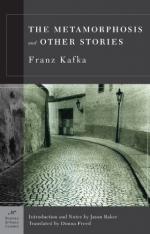|
This section contains 6,078 words (approx. 21 pages at 300 words per page) |

|
SOURCE: "Competing Theories of Identity in Kafka's The Metamorphosis," in Mosaic, Vol. 23, No. 4, Fall, 1990, pp. 23-35.
In the following essay, Sweeney evaluates the tensions of dualist, materialist, and social-constructionist theories of identity represented in The Metamorphosis.
Although The Metamorphosis begins with Gregor Samsa finding "himself changed in his bed into a monstrous vermin," the transformation is at this stage psychologically incomplete, enabling Kafka to conduct a philosophical exploration of the nature of self, personhood and identity. Given the nature of the inquiry, it is significant that instead of providing a monologic commentary with a consistent theoretical framework, Kafka offers a dialogical, polyphonic work, an example of what Mikhail Bakhtin has called a "heteroglossia" of opposed voices (262-64). Since Kafka does not privilege any one theoretical perspective, the reader is encouraged to undertake what Giles Deleuze and Félix Guattari have called an "experimentation" (48-50), a process which involves...
|
This section contains 6,078 words (approx. 21 pages at 300 words per page) |

|


